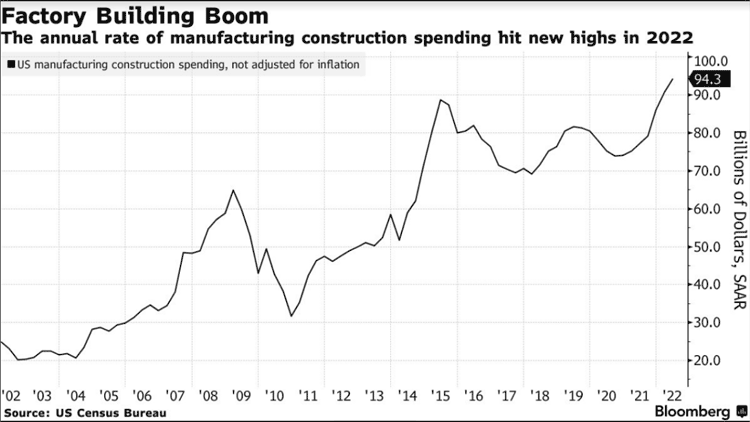For more than a decade there have been predictions that manufacturing would return to US shores, after years of massive outsourcing to China and other low cost countries.
Supply Chain Digest Says...
|
 |
One risk to the movement: a soaring US dollar, which makes it relatively more expensive to make goods in the US rather than in countries using other currencies. |
 |
What do you say? |
| Click here to send us your comments |
 |
| Click here to see reader feedback |
|
But despite anecdotal stories here and there of companies either bringing some production back to the US or deciding to keep manufacturing here rather than offshoring, the movement never really showed up in the numbers.
For example, the monthly index of US manufacturing output from the Federal Reserve Bank came in at a level of 103.1 in May. That means production in the US is up just 3.1% from the baseline year of 2012 (index = 100) now a decade later.
And that level is also well below the all-time high of an index score of 110 in late 2007.
That status quo, however, could actually better changing for the better.
About a week ago, the Dodge Construction Network, which tracks US construction projects, reported that build out of new manufacturing facilities in the US had risen a significant 116% over the past year, dwarfing the 10% gain on all building projects combined.
As example, there are massive chip factories going up in Phoenix. Intel is building two just outside the city and another in Ohio. Taiwan Semiconductor Manufacturing is constructing another one in Phoenix. And aluminum and steel plants that are being erected across the south, including in Alabama (Novelis), Arkansas (US Steel); and Kentucky (Nucor).
There are many other projects planned or underway.
Bloomberg.com reports that dozens of smaller companies are making similar moves.
Of course, not all new factory construction are examples of reshoring. Many are just capacity expansion in the face of strong demand.
But they all share a commom theme - a reassessment of supply chains in the wake of port bottlenecks, parts shortages and delays, and skyrocketing shipping costs.
Bloomberg also reports that Chris Snyder, an industrials analyst at UBS, says most companies for years have thought that “if we need a new facility, it’s going in China.” Now, he says, “this is being thought through in a way that has never been done before.”
(See More Below)
|
CATEGORY SPONSOR: SOFTEON |
|
|
| |
|
|
And there does seem to be some real evidence to support the anecdotes for a change.
The chart below, compiled by Bloomberg from US Census Bureau data, shows the sharp rise in US construction spend on manufacturing plants since mid-2020.

GE Appliance provides an interesting example. The company, ironically, is now actually owned by China’s Haier, but in recent years has brought back much production to its base in Louisville, Kentucky.
“I’ve always said, this is just economics, people are going to realize that the savings they thought they had aren’t real,” Kevin Nolan, the CEO at GE Appliances said in an interview with Bloomberg, “and it’s going to be better and cheaper to make them here.”
One risk to the movement: a soaring US dollar, which makes it relatively more expensive to make goods in the US rather than in countries using other currencies.
What are your thoughts on US reshoring? Let us know your thoughts at the Feedback section below.
|